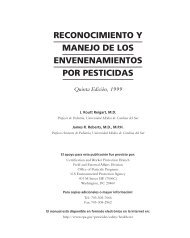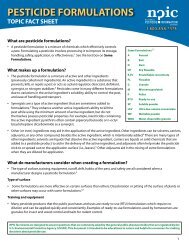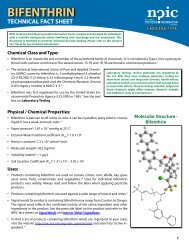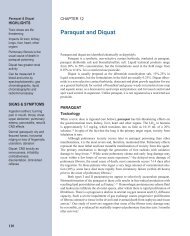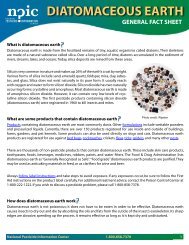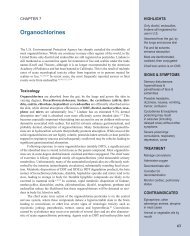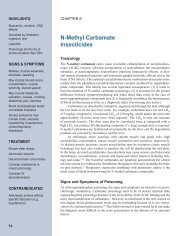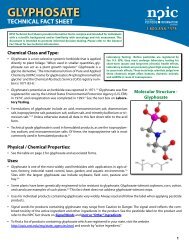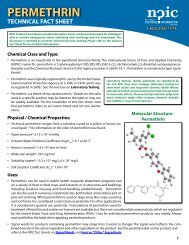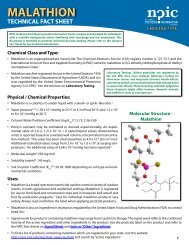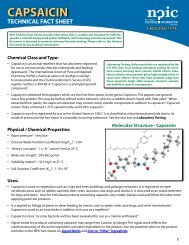Naphthalene Technical Fact Sheet - National Pesticide Information ...
Naphthalene Technical Fact Sheet - National Pesticide Information ...
Naphthalene Technical Fact Sheet - National Pesticide Information ...
- No tags were found...
Create successful ePaper yourself
Turn your PDF publications into a flip-book with our unique Google optimized e-Paper software.
NAPHTHALENETECHNICAL FACT SHEETExposure: Effects of naphthalene on human health and the environment depend on how muchnaphthalene is present and the length and frequency of exposure. Effects also depend on thehealth of a person and/or certain environmental factors.•• A 68-year-old woman developed aplastic anemia following inhalation and possibly dermal exposure to naphthalene andparadichlorobenze, which she placed into containers with stored clothing several hours a day for three weeks while workingfor a clothing resale business. The woman had worked in a room with poor ventilation and no air conditioning duringhot weather, which contributed to high vapor concentrations of naphthalene and paradichlorobenzene. 30Endocrine Disruption:••Atlantic croaker fish ( Micropogonias undulatus) exposed to naphthalene at either 0.5 or 1.0 ppm daily during sexual maturationdemonstrated reduced rates of sexual maturity and arrested or reduced egg development. Reduced egg growthwas associated with decreased gonadal steroid levels in plasma. 31Carcinogenicity:Animals•• Researchers exposed male and female F344 rats to naphthalene vapors at 10, 30, or 60 ppm for 6 hours a day, five days aweek for two years. Respiratory epithelial adenomas and olfactory epithelial neuroblastomas occurred in the noses of bothmales and females. In addition, non-cancerous lesions were also noted in the lungs and noses of the animals. 32•• The <strong>National</strong> Toxicology Program concluded that there was some evidence of carcinogenic activity of naphthalene in femaleB6C3F 1mice. When these mice were exposed to naphthalene vapors for two years at 10 or 30 ppm, they developedincreased rates of bronchiolar and alveolar adenomas. No evidence of carcinogenic activity was found in male mice exposedto the same doses. 33••Embryonic roundworms ( Caenorhabditis elegans) were used in mechanistic studies of the carcinogenicity of naphthalene.The authors hypothesized that the 1,4-naphthoquinone metabolite of naphthalene suppressed normal cell apoptosis. 34Humans•• The International Agency for Research on Cancer (IARC) of the World Health Organization (WHO) concluded that there wasinadequate evidence to evaluate the carcinogenicity of naphthalene to humans, but found sufficient evidence in animalsto conclude that naphthalene is carcinogenic. IARC concluded their evaluation by placing naphthalene in Group 2B, possiblycarcinogenic to humans. 4 See the text box on Cancer.Cancer: Government agencies in the United States and abroad have developed programs to evaluate thepotential for a chemical to cause cancer. Testing guidelines and classification systems vary. To learn moreabout the meaning of various cancer classification descriptors listed in this fact sheet, please visit theappropriate reference, or call NPIC.•• <strong>Naphthalene</strong> is classified as Group C, possible human carcinogen, by the U.S. EPA. This is based on limited evidence of carcinogenicityfollowing inhalation exposure in animals, and lack of data for humans. 35Reproductive or Teratogenic Effects:Animals•• The Agency for Toxic Substances and Disease Registry (ATSDR) reviewed 45 studies that examined the genotoxic potentialof naphthalene. Of these studies, 10 found evidence of chromosomal aberrations, gene mutations, recombination abnormalities,or DNA fragmentation. 15
NAPHTHALENETECHNICAL FACT SHEET••••••Pregnant rabbits were fed 400 mg/kg naphthalene during days 6-18 of their gestation.No adverse effects were noted. 36Researchers dosed pregnant mice by gavage with 300 mg/kg/day during gestation days 7-14. The mice had reduced weightgain, reduced survival rates, and gave birth to fewer young than the controls, although the young appeared normal. 20The difference in results between the rabbit and rat studies above may have been due to the use of different carriers duringadministration, which could have altered the absorption potential of the compound. 1•• Female rats were dosed with 50, 150, or 450 mg/kg/day of naphthalene during days 6-15 of gestation. Researchers measureddecreases in maternal weight gain of 31% and 53% in the mid-dose and high-dose groups, respectively, comparedto the controls. No teratogenic effects were noted. 1,37Humans•• Hemolytic anemia has been reported in infants born to mothers who ingested mothballs or inhaled high concentrationsof naphthalene vapors during pregnancy. 13,38••<strong>Naphthalene</strong> was detected in human breast milk from women in four urban areas near industrial facilities or chemicalmanufacturing plants. 39 <strong>Naphthalene</strong> in the nursing infants was not reported and no further information was found.•• The umbilical cord blood of pregnant women exposed to naphthalene and other volatile organic compounds includingmethylcyclopentane and tetrachloroethylene contained elevated levels of cytokine-producing T-cells. These data suggestthat naphthalene may cross the placenta and affect the immune system of the newborn. 40Fate in the Body:Absorption2••Researchers applied 3.3 µg/cm naphthalene to the skin of rats either alone or in combination with sandy or clay soil. Halfof the dermally applied pure naphthalene reached the bloodstream in 2.1 hours. The absorption half-life of naphthaleneand clay soil was 2.8 hours, and for naphthalene and sandy soil, 4.6 hours. 41 Although adsorption to soil slowed the absorptionof naphthalene, the total amount eventually absorbed by the skin was unchanged. 41••Daily use of baby oil may have increased the absorption of naphthalene through the skin of an infant who wore diapersstored in naphthalene and subsequently developed acute hemolytic anemia. 42•• Once inhaled, naphthalene is thought to enter the body by passive diffusion across the alveolar membranes. Researchershave proposed that naphthalene enters the body through intestinal membrane following oral exposure. 1 Evidence suggeststhat absorption of naphthalene flakes or balls through the intestine can continue for several days after ingestion dueto the slow dissolution of the solid form. 1••No data were found quantifying rates of absorption of naphthalene in humans following either oral or dermal exposure.Distribution•• Tissue distribution of naphthalene was examined following dermal exposure in rats. After 48 hours, 0.56 ± 0.14% (mean ±SE) of the dose was found in the treated skin, 0.02 ± 0.01% in the ileum, 0.01 ± 0.00% in the duodenum, and 0.01 ± 0.00%in the kidney. Most of the dose was excreted. 4143••<strong>Naphthalene</strong> metabolites formed in the liver may reach the lungs via the bloodstream.•• Researchers dosed chickens, swine, and dairy cows via oral intubation for 1 day in an acute study and for 31 days in a chronicexposure study to evaluate the distribution of naphthalene in tissues. 44 The kidneys of the chronically exposed chickenscontained the greatest residual naphthalene and metabolites (2.4 ± 0.22% [mean ± SE] of the original dose), followedby lungs, spleen, liver, and heart. 44 <strong>Naphthalene</strong> residues in the acutely exposed chickens were greatest in the kidneys,fat, lungs, and the liver. 44 The kidneys contained 42.9 ± 1.05% of the dose 24 hours after exposure. Kidney concentrationsdropped to 8 ± 1.07% in 72 hours. 446
NAPHTHALENETECHNICAL FACT SHEET•• Fungal degradation of naphthalene produces naphthalene-1,2-oxide via cytochrome P-450 oxidation. The oxide can besubsequently hydrolyzed to trans-1,2-dihydroxy-1,2-dihydronaphthalene, or alternatively conjugate with glucuronide orsulfate to break down first to 1-naphthol and 2-naphthol and subsequently to 4-hydroxy-1-tetralone. 55 Other reportedmetabolites include naphthalene trans-1,2-dihydrodiol, 1,2-naphthoquinone, and 1,4-naphthoquinone. 52Water51••<strong>Naphthalene</strong> will be lost from water by volatilization, sorption, photolysis, and biodegradation. The relative contributionsof these processes will depend in part on the water’s characteristics, including depth, flow rate, and contamination level. 51••Wastewater from secondary treatment plants was discharged into spreading basins for groundwater recharge. <strong>Naphthalene</strong>concentrations in the wastewater declined 68-94% during movement across the settling basin. 56•• Researchers modeling volatilization of naphthalene from water concluded that evaporation is affected more by watermovement than by air movement above the water’s surface. 57 Maximum volatilization would be expected to occur underconditions of warm temperatures, shallow waters, and wind. Surface films, aerosol formation, waves, water depth, and currentspeed will affect volatilization rates. 57••The presence of algae in the water at concentrations of 1-10 mg chlorophyll a per liter of water increased the photodegradationof naphthalene. 5852••Cyanobacteria and microalgae metabolize naphthalene. The primary metabolite was found to be 1-naphthol, with 4-hydroxy-1-tetraloneand cis-naphthalene dihydrodiol as lesser metabolites. 59,60Air-11••Hydroxyl radicals react with naphthalene in the atmosphere at a rate of 2.17 x 10 cm 3 /molecules sec. 61 Based on this rate,the half-life of naphthalene in air is less than one day. 1 Nitrate may also react with naphthalene in the atmosphere. 51•• Napthalene degraded to form 1-naphthol, 2-naphthol, 1-nitronaphthalene, and 2-nitronaphthalene in the presence of hydroxylradicals and nitric oxides. Researchers noted that other unidentified metabolites also were present. 62Plants•• <strong>Naphthalene</strong> may be deposited on foliage as a result of volatilization from the soil. In addition, naphthalene may be transferredfrom the plant’s roots to the shoots during transpiration. 63••<strong>Naphthalene</strong> adsorbed onto the roots of fescue and alfalfa placed in an aqueous solution containing 18.4 mg/L dissolvednaphthalene. The amount adsorbed was affected by the lipid contents of the roots and plant age. 64••The marsh grass Spartina alterniflora contained more residues of naphthalene in its roots than in the new shoot growthwhen grown in pots containing contaminated soil. 65 Concentrations in soil were four orders of magnitude greater thanthose found in shoots. 65 Roots contained up to 43 µg/g and leaves contained up to 0.2 µg/g naphthalene. 65•• PAH residues in cabbage, carrots, leeks, lettuce and endive grown in an industrial area in northern Greece were most similarto the mixture in air, suggesting that gaseous deposition is a major accumulation pathway. 66Indoor•• <strong>Naphthalene</strong> has been detected in indoor air. It is a product of combustion when organic materials are burned. Tobaccosmoking, cooking, and moth repellents may all be sources of naphthalene indoors. 1•• Clothing stored with naphthalene mothballs may adsorb the naphthalene. The clothing itself then may act as a source ofnaphthalene in indoor air. 679
NAPHTHALENETECHNICAL FACT SHEET3••Indoor air concentrations measured in 24 low-income houses in Durham, NC ranged from 334 to 9700 ng/m naphthalene,with a mean concentration of 2190 ng/m 3 (SD=1870 ng/m 3 ). 68 House dust contained a mean concentration of 0.33 µg/gnaphthalene (SD=0.85 µg/g). 68 Samples were collected from rural and urban areas, and included both smokers’ and nonsmokers’households. 68Food Residue•• No tolerances were found for naphthalene in food.•• Cabbage, carrots, leeks, lettuce and endives were grown in an industrial area in northern Greece, then washed and peeled.The vegetables contained naphthalene at concentrations ranging from 0.37 µg/kg (cabbage) to 63 µg/kg (endive) dryweight. 66•• Researchers measured naphthalene residues in samples of the food consumed by 24 low-income households in NorthCarolina. They found 0.01-18.7 µg/kg naphthalene in the adults’ food (mean= 3.75 µg/kg) and 0.10-54.9 µg/kg naphthalenein the food of the children (mean= 4.08 µg/kg). 68Ecotoxicity Studies:Birds••The acute oral LD in bobwhite quail (Colinus virginianus) was 2690 mg/kg, and the LC was estimated as greater than50 505620 mg/kg. In both cases, naphthalene was considered by the U.S. EPA as practically nontoxic by ingestion. 3Fish and Aquatic Life••The 96-hour LC for rainbow trout (Onchorynchus mykiss) exposed to naphthalene was 2.0 mg/L. The NOAEC was 0.8650mg/L. The 96-hour LC 50in bluegill sunfish (Lepomis macrochirus) was 3.2 mg/L and the NOAEC was 1.4 mg/L. Researchersestimated the 96-hour LC 50in fathead minnows (Pimephales promelas) to be 6.6 mg/L. <strong>Naphthalene</strong> is moderately toxic tothese three species of fish. 3 Embryo-larval toxicity in fathead minnows was noted at concentrations of 0.85 mg/L, and theNOAEC was 0.62 mg/L. 69••The 40-day NOAEC for coho salmon ( Onchoryncus kisutch) exposed to naphthalene was 0.37 mg/L and the 40-day LOAECwas 0.67 mg/L. No ecotoxicity category was assigned. 3 Chronic exposure resulted in reductions in feeding, growth, andsurvival rates. 69••Rainbow trout ( Salmo gairdneri) exposed to 9.2 ppb naphthalene for 72 hours followed by 72 hours of exposure to cleanwater contained increasing concentrations of naphthalene through the exposure period. Fish skin contained 2103 ppbnaphthalene and 440 ppb of metabolites at 72 hours of exposure. Depuration for 72 hours reduced naphthalene levels to223 ppb and metabolites to 275 ppb in the skin. 70 Epidermal mucus was suggested to be an excretion pathway for somecontaminants. 70••Atlantic croaker fish ( Micropogonias undulatus) were exposedto naphthalene at concentrations of 0.5 or 1.0 ppm for up toeight weeks, beginning two weeks before sexual maturity.Fewer exposed fish reached sexual maturity, and many fishthat matured exhibited reduced ovarian growth and delayedor arrested oocyte development. 31••EC 50: The median effective concentration (EC 50) may bereported for sublethal or ambiguously lethal effects. Thismeasure is used in tests involving species such as aquaticinvertebrates where death may be difficult to determine.This term is also used if sublethal events are beingmonitored.Newman, M.C.; Unger, M.A. Fundamentals of Ecotoxicology; CRC Press, LLC.:Boca Raton, FL, 2003; p 178.Reports regarding the toxicity of naphthalene to water fleas(Daphnia magna) are variable. The 48-hour EC 50was 1.6 mg/L,the NOAEC for mortality as an endpoint was 0.48 mg/L, and the NOAEC for sublethal effects was greater than 8.8 mg/L.<strong>Naphthalene</strong> is moderately toxic to water fleas according to the U.S. EPA. 3 See the text box on EC 50.10
NAPHTHALENETECHNICAL FACT SHEET••Pacific oysters ( Crassostrea gigas) exposed to naphthalene had a 96-h EC 50of 199 mg/L, which placed naphthalene in theU.S. EPA’s practically nontoxic category for this species. In contrast, the 96-h LC 50of grass shrimp (Palaemonetes pugio) was2.35 mg/L, which is considered moderately toxic. 3••<strong>Naphthalene</strong> is considered slightly toxic to the green algae ( Chlorella vulgaris) by the U.S. EPA. The 48-hour EC 50was 33mg/L. 3Terrestrial Invertebrates••No data were found on the acute toxicity of naphthalene to the honey bee ( Apis mellifera).••Soil invertebrates (Folsomia candida, or springtail) were exposed to naphthalene in chronic tests. The NOAEC was 88 µmol/kg soil and the LOAEC was 409 µmol/kg soil based on effects on reproduction and survival. 3••Earthworms ( Enchytaeus crypticus) were also studied following chronic exposure to naphthalene in soil. The NOAEC was220 µmol/kg soil and the LOAEC was 2045 µmol/kg soil. 3••Pseudomonas putida bacteria were added to soil that had been mixed with naphthalene 68 days earlier, and soil that hadjust been mixed with naphthalene. The bacteria metabolized the freshly treated soil much more rapidly, suggesting thataging of naphthalene in the soil matrix made it unavailable for biodegradation. 71 In both cases, most of the degradationoccurred in the first 3 days. 71••In the same study, earthworms ( Eisenia foetida) incorporated 2.3% of radioactive naphthalene from freshly treated soil intotheir bodies, but only 1.4% of radioactive naphthalene that had been added to soil 68 days earlier. 71Regulatory Guidelines:•• The U.S. EPA set the chronic reference dose or cRfD fornaphthalene at 0.1 mg/kg/day and acute referencedose or aRfD at 0.4 mg/kg/day for naphthalene basedon studies of exposure in rats. 3 See the text box on ReferenceDose.•• The U.S. EPA classifies naphthalene as Group C, possiblehuman carcinogen. 35 The IARC classification is Group 2B,possibly carcinogenic to humans. 4 See the text box onCancer (page 5).••The Recommended Exposure Limit (REL) for a time-weighted average (TWA) is 10 ppm or 50 mg/m 3, and the Short TermExposure Limit (STEL) is 15 ppm or 75 mg/m 3 . 723••The Permissible Exposure Limit (PEL) is 10 ppm or 50 mg/m for naphthalene. 72Date Reviewed: November 2010Reference Dose (RfD): The RfD is an estimate of the quantity ofchemical that a person could be exposed to every day for the restof their life with no appreciable risk of adverse health effects. Thereference dose is typically measured in milligrams (mg) of chemicalper kilogram (kg) of body weight per day.U.S. Environmental Protection Agency, Technology Transfer Network, Air Toxics HealthEffects Glossary, 2009. http://www.epa.gov/ttnatw01/hlthef/hapglossaryrev.html#RfDPlease cite as: Gervais, J.; Luukinen, B.; Buhl, K.; Stone, D. 2010. <strong>Naphthalene</strong> <strong>Technical</strong> <strong>Fact</strong> <strong>Sheet</strong>; <strong>National</strong> <strong>Pesticide</strong><strong>Information</strong> Center, Oregon State University Extension Services. http://npic.orst.edu/factsheets/naphtech.pdf.References1. Toxicological Profile for <strong>Naphthalene</strong>, 1-methylnaphthalene, and 2-methylnaphthalene; U.S Department of Health and HumanServices, Public Health Service, Agency for Toxic Substances and Disease Registry. http://www.atsdr.cdc.gov/toxprofiles/tp.asp?id=240&tid=43 (accessed March 2010), updated Sept 2010.11
NAPHTHALENETECHNICAL FACT SHEET2. Bischoff, K. <strong>Naphthalene</strong>. Clinical Veterinary Toxicology; Plumlee, K. H., Ed.; Mosby: St. Louis, MO, 2004, pp. 163-164.3. Reregistration Eligibility Decision (RED): <strong>Naphthalene</strong>; EPA 738-R-07-010; U.S. Environmental Protection Agency, Office of Prevention,<strong>Pesticide</strong>s and Toxic Substances, Office of <strong>Pesticide</strong> Programs, U.S. Government Printing Office: Washington, DC, 2008.4. WHO. IARC Monographs on the Evaluation of Carcinogenic Risks to Humans; International Agency for Research on Cancer, WorldHealth Organization: Lyon, France, 2002; pp 367-435.5. Preuss, R.; Angerer, J.; Drexler, H. <strong>Naphthalene</strong> - An environmental and occupational toxicant. Int. Arch. Occup. Environ. Health 2003,76, 556-576.6. Hazardous Substances Data Bank (HSDB): <strong>Naphthalene</strong>; U.S. Department of Health and Human Services, <strong>National</strong> Institutes of Health,<strong>National</strong> Library of Medicine. http://toxnet.nlm.nih.gov/cgi-bin/sis/htmlgen?HSDB (accessed March 2010), updated June 2005.7. WHO. <strong>Naphthalene</strong> (PIM 363); International Programme on Chemical Safety, World Health Organization. http://www.inchem.org/documents/pims/chemical/pim363.htm (accessed March 2010), updated Sept 2000.8. Bogen, K. T.; Benson, J. M.; Yost, G. S.; Morris, J. B.; Dahl, A. R.; Clewell, H. J., III; Krishnan, K.; Omiecinski, C. J. <strong>Naphthalene</strong> metabolism inrelation to target tissue anatomy, physiology, cytotoxicity and tumorigenic mechanism of action. Reg. Toxicol. Pharmacol. 2008, 51,S27-S36.9. Buckpitt, A. R.; Boland, B.; Isbell, M.; Morin, D.; Shultz, M.; Baldwin, R.; Chan, K.; Karlsson, A.; Lin, C.; Taff, A.; West, J.; Fanucchi, M.; VanWinkle, L.; Plopper, C. G. <strong>Naphthalene</strong>-induced respiratory tract toxicity: metabolic mechanisms of toxicity. Drug Metab. Rev. 2002, 34(4), 791-820.10. Reigart, J. R.; Roberts, J. R. Fumigants. Recognition and Management of <strong>Pesticide</strong> Poisonings, 5th ed.; U.S. Environmental ProtectionAgency, Office of Prevention, <strong>Pesticide</strong>s and Toxic Substances, Office of <strong>Pesticide</strong> Programs, U.S. Government Printing Office:Washington, DC, 1999; pp 156-162.11. Valaes, T.; Doxiadis, S. A.; Fessas, P. Acute hemolysis due to naphthalene inhalation. J. Pediatr. 1963, 63, 904-915.12. Santucci, K.; Shah, B. R. Association of naphthalene with acute hemoyltic anemia. Acad. Emerg. Med. 2000, 7, 42-47.13. Molloy, E. J.; Doctor, B. A.; Reed, M. D.; Walsh, M. C. Perinatal toxicity of domestic naphthalene exposure. J. Perinatol. 2004, 24, 792-793.14. Phimister, A. J.; Lee, M. G.; Morin, D.; Buckpitt, A. R.; Plopper, C. G. Glutathione depletion is a major determinant of inhalednaphthalene respiratory toxicity and naphthalene metabolism in mice. Toxicol. Sci. 2004, 82, 268-278.15. Phimister, A. J.; Nagasawa, H. T.; Buckpitt, A. R.; Plopper, C. G. Prevention of naphthalene-induced pulmonary toxicity by glutathioneprodrugs: roles for glutathione depletion in adduct formation and cell injury. J. Biochem. Mol. Toxicol. 2005, 19 (1), 42-51.16. Wilson, A. S.; Davis, C. D.; Williams, D. P.; Buckpitt, A. R.; Pirmohamed, M.; Park, B. K. Characterization of the toxic metabolite(s) ofnaphthalene. Toxicol. 1996, 114, 233-242.17. Papciak, R. J.; Malloy, V. T. Acute toxicological evaluation of naphthalene. J. Am. Coll. Toxicol. 1990, 1 (1), 17-19.18. Gaines, T. B. Acute toxicity of pesticides. Toxicol. Appl. Pharmacol. 1969, 14, 515-534.19. Shopp, G. M.; White, K. L., Jr.; Holsapple, M. P.; Barnes, D. W.; Duke, S. S.; Anderson, A. C.; Condie, L. W.; Hayes, J. R.; Borzelleca, J. F.<strong>Naphthalene</strong> toxicity in CD-1 mice: general toxicology and immunotoxicology. Fundam. Appl. Toxicol. 1984, 4, 406-419.20. Plasterer, M. R.; Bradshaw, W. S.; Booth, G. M.; Carter, M. W. Developmental toxicity of nine selected compounds following prenatalexposure in the mouse: naphthalene, p-nitrophenol, sodium selenate, dimethyl phthalate, ethylenethiourea, and four glycol etherderivatives. J. Toxicol. Environ. Health 1985, 15, 25-38.21. West, J. A. A.; Pakehham, G.; Morin, D.; Fleschner, C. A.; Buckpitt, A. R.; Plopper, C. G., Inhaled naphthalene causes dose dependent claracell cytotoxicity in mice but not in rats. Toxicol. Appl. Pharmacol. 2001, 173, 14-119.22. Witschi, H. R.; Pinkerton, K. E.; Van Winkle, L. S.; Last, J. A. Toxic responses of the respiratory system. Casarette and Doull’s Toxicology:The basic science of poisons, 7th ed.; Klaassen, C. D., Ed.; McGraw Hill Medical: New York, 2008; p 613.23. Zuelzer, W. W.; Apt, L. Acute hemolytic anemia due to naphthalene poisoning. J. Am. Med. Assoc. 1949, 141 (3), 185-190.24. Desnoyers, M.; Hebert, P. Heinz body anemia in a dog following possible naphthalene ingestion. Vet. Clin. Pathol. 1995, 24 (4), 124-125.25. Health Effects Support Document for <strong>Naphthalene</strong>; EPA 822-R-03-005; U.S. Environmental Protection Agency, Office of Water, Healthand Ecological Criteria Division, U.S. Governement Printing Office: Washington, DC, 2003.26. Grant, W. M. Toxicology of the Eye, 3rd ed.; Charles C. Thomas: Springfield, IL, 1986, pp 650-645.12
NAPHTHALENETECHNICAL FACT SHEET27. Coombs, D. <strong>Naphthalene</strong> 4-week inhalation study in rats. Unpublished lab project no. LDA 1/921559, 1993, submitted to U.S.Environmental Protection Agency by Huntingdon Research Center, Ltd. EPA MRID 42934901 Reregistration Elegibility Decision(RED) <strong>Naphthalene</strong>; U.S. Environmental Protection Agency, Office of Prevention, <strong>Pesticide</strong>s and Toxic Substances, Office of <strong>Pesticide</strong>Programs, U.S. Government Printing Office: Washington, DC, 2008, p 14.28. Frantz, S.; Van Miller, J.; Papciak, R. Ninety-day (sub-chronic) dermal toxicity study with naphthalene in albino rats: final report.Unpublished project no. 49- 539, 1986, submitted to U.S. Environmental Protection Agency by Union Carbide Bushy Run ResearchCenter. EPA MRID 40021801. Reregistration Elegibility Decision (RED) <strong>Naphthalene</strong>; U.S. Environmental Protection Agency, Office ofPrevention, <strong>Pesticide</strong>s and Toxic Substances, Office of <strong>Pesticide</strong> Programs, U.S. Government Printing Office: Washington, DC, 2008, p14.29. Shah, B. R.; Santucci, K. <strong>Naphthalene</strong> induced acute hemolytic-anemia in children with glucose-6-phosphate-dehydrogenase (G-6-PD) deficiency - naphthalene has no legitimate place on the market as a moth repellent. Pediatr. Res. 1995, 37 (4), A144.30. Harden, R. A.; Baetjer, A. M. Aplastic anemia following exposure to paradichlorobenzene and naphthalene. J. Occup. Med. 1978, 20(12), 820-822.31. Thomas, P.; Budiantara, L. Reproductive life history stages sensitive to oil and naphthalene in Atlantic croaker. Mar. Environ. Res. 1995,39, 147-150.32. Abdo, K. M.; Grumbein, S.; Chou, B. J.; Herbert, R. Toxicity and carcinogenicity study in F344 rats following 2 years of whole-bodyexposure to naphthalene vapors. Inhal. Toxicol. 2001, 13, 931-950.33. NTP <strong>Technical</strong> Report on the toxicology and carcinogenesis studies of naphthalene (CAS No. 91-20-3) in B6C3F 1mice. U.S. Departmentof Health and Human Services, Public Health Service, <strong>National</strong> Institutes of Health, <strong>National</strong> Toxicology Program: Research TrianglePark, NC, 1992; pp 35-36.34. Kokel, D.; Li, Y.; Qin, J.; Xue, D., The nongenotoxic carcinongens naphthalene and para-dichlorobenzene suppress apoptosis inCaenorhabditis elegans. Nat. Chem. Biol. 2006, 2 (6), 338-345.35. Integrated Risk <strong>Information</strong> System (IRIS): <strong>Naphthalene</strong> (CASRN 91-20-3); U.S. Environmental Protection Agency. http://www.epa.gov/NCEA/iris/subst/0436.htm (accessed March 2010), updated Jan 2008.36. Developmental toxicity study in rabbits: naphthalene. Unpublished report number PH 329-TX-001 85, 1986, submitted toU.S. Department of Health and Human Services by Pharmakon Research International, Inc. Toxicologial Profile for naphthalene,1-methylnaphthalene, and 2-methylnaphthalene; U.S Department of Health and Human Services, Public Health Service, Agency forToxic Subtances and Disease Registry: Atlanta, 2005; p 75.37. Developmental toxicity of naphthalene (CAS No. 91-20-3) administered by gavage to Sprague-Dawley (CD) rats on gestational days 6through 15: Final study report and appendix.U.S. Department of Health and Human Services, Public Health Service, <strong>National</strong> Institutesof Health, <strong>National</strong> Toxicology Program, TER91006: Research Triangle Park, NC, 1991, p 76.38. Anziulewicz, J. A.; Dick, H. J.; Chiarulli, E. E. Transplacental naphthalene poisoning. Am. J. Obstet. Gynecol. 1959, 78 (3), 519-521.39. Pellizzari, E. D.; Hartwell, T. D.; Harris, B. S. H., III; Waddell, R. D.; Whitaker, D. A.; Erickson, M. D. Pureable organic compounds in mother’smilk. Bull. Environ. Contam. Toxicol. 1982, 28, 322-328.40. Lehmann, I.; Thoelke, A.; Rehwagen, M.; Rolle-Kampczyk; Schlink, U.; Schulz, R.; Borte, M.; Diez, U.; Herbarth, O. The influence ofmaternal exposure to volatile organic compounds on the cytokine secretion profile of neonatal T cells. Environ. Toxicol. 2002, 17 (3),203-210.41. Turkall, R. M.; Skowronsi, G. A.; Abdel-Rahman, M. S. A comparative study of the kinetics and bioavailability of pure and soil-adsorbednaphthalene in dermally exposed male rats. Arch. Environ. Contam. Toxicol. 1994, 26, 504-509.42. Schafer, W. B. Acute hemolytic anemia related to naphthalene. Pediatrics 1951, 7, 172-174.43. Buckpitt, A. R., Evidence for hepatic formation, export and covalent binding of reactive naphthalene metabolites in extrahepatictissues in vivo. J. Pharmacol. Exp. Ther. 1983, 225 (1), 8-16.44. Eisele, G. R. <strong>Naphthalene</strong> distribution in tissues of laying pullets, swine, and dairy cattle. Bull. Environ. Contam. Toxicol. 1985, 34, (549-556).45. O’Brien, K. A. F.; Suverkropp, C.; Kanekal, S.; Plopper, C. G.; Buckpitt, A. R. Tolerance to multiple doses of the pulmonary toxicant,naphthalene. Toxicol. App. Pharmacol. 1989, 99, 487-500.13
NAPHTHALENETECHNICAL FACT SHEET46. West, J. A. A.; Buckpitt, A. R.; Plopper, C. G. Elevated airway GSH reysnthesis confers protection to Clara cells from naphthalene injuryin mice made tolerant by repeated exposures. J. Pharmacol. Exp. Ther. 2000, 294 (2), 516-523.47. Van Heyningen, R.; Pirie, A. The metabolism of naphthalene and its toxic effect on the eye. Biochem. J. 1967, 102, 842-852.48. Bieniek, G. Urinary naphthols as an indicator of exposure to naphthalene. Scand. J. Work Environ. Health 1997, 23, 414-420.49. Bieniek, G., The presence of 1-naphthol in the urine of industrial workers exposed to naphthalene. Occup. Environ. Med. 1994, 51,357-359.50. Yang, M.; Koga, M.; Tawamoto, T. A study for the proper application of urinary naphthols, new biomarkers for airborne polycyclicaromatic hydrocarbons. Arch. Environ. Contam. Toxicol. 1999, 36, 99-108.51. Howard, P. H. <strong>Naphthalene</strong>. Handbook of Environmental Fate and Exposure Data for Organic Chemcials; Jarvis, W. F.; Sage, G. W.; Basu, D.K.; Gray, D. A.; Meylan, W.; Crosbie, E. K., Eds; Lewis Publishers: Chelsea, MI, 1989; Vol. 1, pp 408-422.52. Cerniglia, C. E. Biodegradation of polycyclic aromatic hydrocarbons. Biodegradation 1992, 3, 351-368.53. Jury, W. A.; Spencer, W. F.; Farmer, W. J. Behavior assessment model for trace organics in soil: III. Application of screening model. J.Environ. Qual. 1984, 13 (4), 573-479.54. Treccani, V.; Walker, N.; Wiltshire, G. H., The metabolism of naphthalene by soil bacteria. J. Gen. Microbiol. 1954, 11, 341-348.55. Cerniglia, C. E., Microbial metabolism of polycyclic aromatic hydrocarbons. Adv. Appl. Microbiol. 1984, 30, 31-71.56. Bouwer, E. J.; McCarty, P. L.; Bouwer, H.; Rice, R. C. Organic contaminant behavior during rapid infiltration of secondary wastewater atthe Phoenix 23rd Avenue Project. Water Res. 1984, 18 (4), 463-472.57. Southworth, G. R. The role of volatilization in removing polycyclic aromatic hydrocarbons from aquatic environments. Bull. Environ.Contam. Toxicol. 1979, 21, 507-514.58. Zepp, R. G.; Schlotzhauer, P. F. Influence of algae on photolysis rates of chemicals in water. Environ. Sci. Technol. 1983, 17, 462-466.59. Cerniglia, C. E.; van Baalen, C.; Gibson, D. T., Metabolism of naphthalene by the cyanobacterium Oscillatoria sp., strain JCM. J. Gen.Microbiol. 1980, 116, 485-494.60. Cerniglia, C. E.; Gibson, D. T.; van Baalen, C. Oxidation of naphthalene by cyanobacteria and microalgae. J. Gen. Microbiol. 1980, 116,495-500.61. Atkinson, R. Kinetics and mechanisms of the gas-phase reactions of the hydroxyl radical with organic compounds underatmospheric conditions. Chem. Rev. 1986, 86, 69-201.62. Atkinson, R.; Arey, J.; Zielinska, B.; Aschmann, S. M., Kinetics and products of the gas-phase reactions of OH radicals and N O with2 5naphthalene and biphenyl. Environ. Sci. Technol. 1987, 21, 1014-1022.63. Gao, Y.; Collins, C. D. Uptake pathways of polycyclic aromatic hydrocarbons in white clover. Environ. Sci. Technol. 2009, 43 (16), 6190-6195.64. Schwab, A. P.; Al-Assi, A. A.; Banks, M. K. Adsorption of naphthalene onto plant roots. J. Environ. Qual. 1998, 27, 220-224.65. Watts, A. W.; Ballestero, T. P.; Gardner, K. H. Uptake of polycyclic aromatic hydrocarbons (PAHs) in salt marsh plants Spartinaalterniflora grown in contaminated sediments. Chemosphere 2006, 62, 1253-1260.66. Kipopoulou, A. M.; Manoli, E.; Samara, C. Bioconcentration of polycyclic aromatic hydrocarbons in vegetables grown in an industrialarea. Environ. Pollut. 1999, 106, 369-380.67. De Coensel, N.; Desmet, K.; Sandra, P.; Gorecki, T. Domestic sampling: exposure assessment to moth repellent products usingultrasonic extraction and capillary GC-MS. Chemosphere 2008, 71, 711-716.68. Chuang, J. C.; Callahan, P. J.; Lyu, C. W.; Wilson, N. K. Polycyclic aromatic hydrocarbon exposures of children in low-income families. J.Expo. Anal. Environ. Epidemiol. 1999, 2, 85-98.14For more information contact: NPICOregon State University, 310 Weniger Hall, Corvallis, OR 97331-6502Phone: 1-800-858-7378 Fax: 1-541-737-0761Email: npic@ace.orst.edu Web: npic.orst.edu
NAPHTHALENETECHNICAL FACT SHEET69. Revised Ecological Risk Assessment for the Reregistration Elegibility Decision (RED) for <strong>Naphthalene</strong>; U.S. Environmental ProtectionAgency, Offices of Prevention, <strong>Pesticide</strong>s, and Toxic Substances, Environmental Fate and Effects Division, U.S. Government PrintingOffice: Washington, DC, 2008.70. Varanasi, U.; Uhler, M.; Stranahan, S. I. Uptake and release of naphthalene and its metabolites in skin and epidermal mucus ofsalmonids. Toxicol. Appl. Pharmacol. 1978, 44, 277-289.71. Kelsey, J. W.; Alexander, M., Declining bioavailability and inappropriate estimation of risk of persistent compounds. Environ. Toxicol.Chem. 1997, 16 (3), 582-585.72. NIOSH Pocket Guide to Chemical Hazards: <strong>Naphthalene</strong>; U.S. Department of Health and Human Services, Centers for Disease Controland Prevention, <strong>National</strong> Institure for Occupational Safety and Health. http://www.cdc.gov/NIOSH/npg/npgd0439.html (accessedMarch 2010), updated Sept 2005.NPIC is a cooperative agreement between Oregon State University and the U.S. Environmental ProtectionAgency (U.S. EPA, cooperative agreement # X8-83458501). The information in this publication does not in anyway replace or supersede the restrictions, precautions, directions, or other information on the pesticide label orany other regulatory requirements, nor does it necessarily reflect the position of the U.S. EPA.15





